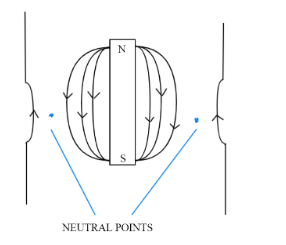
What is the resultant magnetic field at a neutral point?
${\text{A}}{\text{.}}$ Zero
${\text{B}}{\text{.}}$ > Zero
${\text{C}}{\text{.}}$ < Zero
${\text{D}}{\text{.}}$ Maximum
Answer
589.2k+ views
Hint:- Here, we will proceed by defining the term magnetic field which is widely used in physics. Then, we will define the neutral point along with the net or resultant magnetic field that is there.
Step By Step Answer:

A magnetic field is a vector field that defines the magnetic effect in relative motion of electrical charges and magnetic materials. A charge which moves parallel to a current of other charges is experiencing a force perpendicular to its own velocity. The effects of magnetic fields are usually seen in permanent magnets that attract or repel other magnets from magnetic materials (such as iron). Magnetic fields, including those used in electromagnets, surround and are formed by magnetized material and by moving electrical charges (currents).
A neutral point of any magnet is defined as a point at which the resultant magnetic field is always zero. When the horizontal component of the earth’s field is balanced with the help of a magnet, this leads to a neutral point. It is obtained when the north pole of the magnet points to the south and the magnet in the magnetic meridian.
The superposition of the magnetic fields due to earth and bar magnet is represented by the curves when the magnetic field of a bar magnet is plotted.
A point where the magnetic fields produced due to the magnet is completely neutralized by the horizontal component of the magnetic field produced due to earth is known as a neutral point. It is also important to note that the field produced due to the bar magnet is equal and opposite to the horizontal component of the magnetic field produced due to earth.
i.e., B = ${{\text{B}}_{\text{H}}}$ where B denotes the magnetic field produced due to bar magnet and ${{\text{B}}_{\text{H}}}$ denotes the horizontal component of the magnetic field produced due to earth.
Therefore, the resultant magnetic field at a neutral point is zero.
Hence, option A is correct.
Note- The magnetic fields exert forces on electrical charges which are moving and torques on nearby magnets. Furthermore, a location-varying magnetic field exerts a force on magnetic materials. The intensity of a magnetic field and its direction differ with the location.
Step By Step Answer:

A magnetic field is a vector field that defines the magnetic effect in relative motion of electrical charges and magnetic materials. A charge which moves parallel to a current of other charges is experiencing a force perpendicular to its own velocity. The effects of magnetic fields are usually seen in permanent magnets that attract or repel other magnets from magnetic materials (such as iron). Magnetic fields, including those used in electromagnets, surround and are formed by magnetized material and by moving electrical charges (currents).
A neutral point of any magnet is defined as a point at which the resultant magnetic field is always zero. When the horizontal component of the earth’s field is balanced with the help of a magnet, this leads to a neutral point. It is obtained when the north pole of the magnet points to the south and the magnet in the magnetic meridian.
The superposition of the magnetic fields due to earth and bar magnet is represented by the curves when the magnetic field of a bar magnet is plotted.
A point where the magnetic fields produced due to the magnet is completely neutralized by the horizontal component of the magnetic field produced due to earth is known as a neutral point. It is also important to note that the field produced due to the bar magnet is equal and opposite to the horizontal component of the magnetic field produced due to earth.
i.e., B = ${{\text{B}}_{\text{H}}}$ where B denotes the magnetic field produced due to bar magnet and ${{\text{B}}_{\text{H}}}$ denotes the horizontal component of the magnetic field produced due to earth.
Therefore, the resultant magnetic field at a neutral point is zero.
Hence, option A is correct.
Note- The magnetic fields exert forces on electrical charges which are moving and torques on nearby magnets. Furthermore, a location-varying magnetic field exerts a force on magnetic materials. The intensity of a magnetic field and its direction differ with the location.
Recently Updated Pages
The number of solutions in x in 02pi for which sqrt class 12 maths CBSE

Write any two methods of preparation of phenol Give class 12 chemistry CBSE

Differentiate between action potential and resting class 12 biology CBSE

Two plane mirrors arranged at right angles to each class 12 physics CBSE

Which of the following molecules is are chiral A I class 12 chemistry CBSE

Name different types of neurons and give one function class 12 biology CBSE

Trending doubts
Which are the Top 10 Largest Countries of the World?

What are the major means of transport Explain each class 12 social science CBSE

Draw a labelled sketch of the human eye class 12 physics CBSE

Differentiate between insitu conservation and exsitu class 12 biology CBSE

The computer jargonwwww stands for Aworld wide web class 12 physics CBSE

State the principle of an ac generator and explain class 12 physics CBSE




